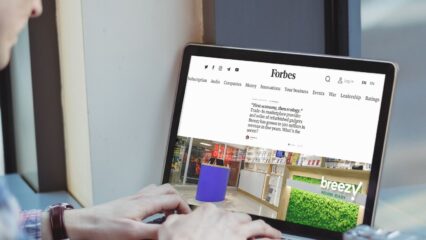Interview with Andrii Kosar
Andrii Kosar, CEO and Co-founder of Breezy, shared his insights on the best way to adapt a business strategy to a significant shift towards digital and e-commerce solutions that the retail industry faces in an interview with Kieran Powell for Authority Magazine on Medium. Read an interview on Medium or below on the page. …

Andrii Kosar, CEO and Co-founder of Breezy, shared his insights on the best way to adapt a business strategy to a significant shift towards digital and e-commerce solutions that the retail industry faces in an interview with Kieran Powell for Authority Magazine on Medium.
Read an interview on Medium or below on the page.
The retail industry is undergoing a seismic shift, largely driven by technology. From e-commerce to AI-driven customer experiences, technology is redefining how consumers interact with retail brands. This rapid transformation presents unique challenges and opportunities for C-level leaders in the retail tech space. Effective leadership is more critical than ever to navigate these changes, drive innovation, and maintain a competitive edge. As part of this series, we had the pleasure of interviewing Andrii Kosar.
Andrii Kosar is the CEO and Co-Founder of Breezy, a retail tech company, specializing in providing in-store and online trade-in solutions for major retailers in the personal electronics space, working with over 40 authorized resellers of Apple, Samsung, Xiaomi, and more (across over 3500 stores). With over ten years of experience in retail management, Andrii has built extensive expertise that has enabled him to lead a world-class organization where excellent customer experience, innovations, and sustainability are the top priorities. He is passionate about making modern technologies more affordable for customers while reducing the environmental footprint of electronics. Andrii’s understanding of the retail industry trends and tendencies and effective leadership have steered the company, originally founded in Ukraine, to become a leading trade-in provider in the countries of operation.
Thank you so much for your time! I know that you are a very busy person. Our readers would love to “get to know you” a bit better. Can you tell us a bit about your ‘backstory’ and how you got started?
Before your question, I hadn't reflected on how my diverse experiences assisted my efficiency as CEO. My entrepreneurial and leadership journey began during my early student years. With friends, I delved into server rentals for gamers, sold branded sneakers, and offered SMM before it became mainstream—just a glimpse of the many ventures I initiated then. Despite the short-term nature of these projects due to funding constraints, they played a crucial role in fostering a positive mindset. The ability to embrace new challenges, persist through difficulties, and maintain belief in projects, even in the face of failures, is essential for any leader.
Simultaneously, during my student years, I entered the retail sector. This was not a planned career move. A life-changing event, the passing of my father, left my family without a source of income. Since then, there hasn't been a day that I haven't worked. I progressed from a sales consultant to a store manager within a year. Subsequently, I initiated and implemented many retail projects—encompassing sales development, staff training, the evolution of retail formats, and ventures related to computer production, service center management, and crisis management. I concurrently developed my marketing agency.
The amalgamation of this multifaceted experience in production, sales, customer service, and marketing consulting, coupled with an IT education, laid the foundation for establishing my own retail tech company Breezy, which has seen successful scaling ever since.
It has been said that our mistakes can be our greatest teachers. Can you share a story about the funniest mistake you made when you were first starting? Can you tell us what lesson you learned from that?
I recall a moment early in my career before a crucial meeting with a partner when I accidentally spilled coffee on myself, completely ruining my shirt. With only 15 minutes left, I rushed to a nearby store, where the only available white shirt in my size bore a bold inscription on the back–' A King of Marketing.' Considering I had to present a marketing project for a large company at the meeting, such a proclamation could easily be misconstrued as excessive conceit.
Facing the reality that the elephant in the room couldn't be ignored, I addressed it head-on. I began the meeting by sharing the comical story of my shirt misadventure. Surprisingly, this candid revelation helped break the ice and establish a positive rapport with the client.
What did I take away from this experience? It taught me that what seems like a disaster at the moment is often not. It's not the incident, but how you react to it, that truly matters. Small mistakes won't diminish how people perceive you; social psychology suggests that such missteps can make a professional more relatable than someone with impeccable practice—this is known as the pratfall effect.
And, of course, since then, I have always kept a spare shirt on hand.
Are you working on any exciting new projects now? How do you think that will help people?
We have several exciting projects currently underway, each with its unique impact. One of our latest endeavors is focused on factory robotization, a game-changer in expediting the restoration process of devices before they hit the market. This not only enhances the speed and efficiency of the restoration but also contributes to cost-effectiveness.
We're developing an AI-based solution to identify phone defects within the factory transformation context. This technology seamlessly integrates into our trade-in application, which we've incorporated across over 40 retail chains. The speed and precision of our valuation system not only make the process more convenient for retailers and enable us to offer customers the fairest prices.
Another project close to my heart involves non-profit initiatives. We've created a charity mechanism that empowers individuals to make a meaningful impact on those in need. The core of this initiative lies in our trade-in service, allowing people to transform old, unused technology in their homes into brand-new gadgets for those who might not have access otherwise. Consider it turning old gadgets into new opportunities, particularly for orphanage children. As part of this project, we're excited about upcoming collaborations with well-known brands and influencers. Our singular goal is to make a positive difference in the lives of those who need it most. I firmly believe that the role of business should extend beyond profit; it's an opportunity to contribute to a better world. We're committed to making a difference, one gadget at a time, and I invite everyone who shares this vision to join us in this journey to do good.

Thank you for that. Let’s now shift to the central focus of our discussion. The retail industry has seen a significant shift towards digital and e-commerce solutions. How have you adapted your business strategy to this digital transformation, and what challenges did you face in this transition?
Our situation takes a somewhat paradoxical twist. We initially entered the market as an online store, specializing in selling high-quality second-life equipment across three markets simultaneously. Within a year, we gained a leading position in this space. Over the past year, we have been developing our network of retail stores. This movement stems from the unique dynamics of consumer behavior in the used equipment segment, which often remains opaque to the client.
For instance, most major market players only provide information about the product grade, not about specific devices. Consequently, customers can't be sure about the condition of the gadget they'll receive. Although we have created a unique customer experience based on transparency, some customers still prefer to verify the quality of gadgets in person when it comes to used ones. To accommodate this preference, we're actively developing a retail network of stores under our brand and through partner stores that sell equipment we've meticulously restored.
Retail technology is heavily focused on enhancing customer experience. Can you share a particular innovation your company has implemented to improve customer engagement and satisfaction? How did this innovation impact your business?
As I mentioned earlier, customer transparency is at the core of our strategy. To bring this to life, we've developed a business process for device refurbishment to provide each gadget with a detailed repair and testing history across over 55 parameters, complemented by highly detailed photographs. This information is readily accessible to in-store clients via a QR code or our website for each IMEI. This approach streamlines the purchasing decision-making process and instills confidence in the result. Achievement of this level of transparency required developing a dedicated ERP solution and extensive data storage for each device treated as a unique product. The impact of these innovations has been transformative, radically enhancing the overall customer experience.
Furthermore, we've integrated a machine learning-based solution in our retail stores. This technology enables every gadget on display to recognize key demographic indicators and visitor emotions. We can instantly tailor personalized content or offer special promotions by leveraging this data. This enhances the overall shopping experience and, through improved analytics, allows us to gauge customer interest and continuously refine our offerings to meet their evolving needs.
Leading a retail tech company often means keeping up with rapid technological changes and market trends. How do you stay ahead of these trends, and what practices do you follow to ensure your team remains agile and innovative?
Leading a retail tech company means navigating a landscape marked by rapid technological advancements and dynamic market trends. Innovations enable embracing emerging technologies for tool and approach enhancement and adapting business models and processes to evolving consumer behaviors.
We've fostered a culture deeply rooted in innovation to cultivate a team ready to implement new ideas. This culture is a reflection of organizational values and the personal values of top management.
A robust project office is also a crucial component for effective innovation implementation. Given the multitude of project ideas, it's vital to methodically sort them into 'must-haves' and 'nice-to-haves' with appropriate prioritization at the outset.
Segmented teams, each specializing in different functionalities, play a pivotal role in critical areas of development. This approach facilitates efficient management and ensures flexibility and in-depth knowledge within each team. Equally important is the active involvement of top management in projects. I actively participate in backlog discussions bi-weekly, as I believe such leadership engagement is critical to the company’s success.
In an industry increasingly dominated by technology, how do you balance the use of tech solutions with the need for a human touch in customer service and team management?
In an era increasingly defined by technology, striking the right balance between tech solutions and a human touch in customer service and team management is paramount.
At the heart of our approach to building customer experiences and managing teams is the belief that people naturally prefer interacting with people. As such, all processes directly related to customer service, handling objections, and training sales staff have a human touch. Simultaneously, we harness the power of automation, artificial intelligence, and robotization to enhance the effectiveness of these interactions and improve overall productivity.
We recognize the importance of leveraging technological solutions where mitigating the risk of error is critical, such as in production, document flow, testing, etc. For instance, while a human staff excels in advising on trade-in issues—capturing the client’s mood, selecting the right tone, and presenting compelling reasoning—the speed and precision in assessing a gadget are guaranteed by an automated module. At the factory, a robot meticulously checks devices, handles packaging, and captures high-resolution photographs. Such repetitive tasks, prone to human errors, thrive when entrusted to technologies, ensuring efficiency and accuracy in our operations.
Ok, here is the main question of our discussion. Based on your experience and success, what are the “5 Things You Need To Be A Highly Effective C-Level Leader Of A Retail Tech Company?” How have these 5 things impacted your work or your career? Please share a story or an example for each.
1 . Building a Strong Team: The ability to assemble and motivate a robust team is crucial. I am proud that the core of my team has been with me for the past seven years, a remarkable duration in the ever-changing retail business. Many started in entry-level positions, and recognizing their potential, I created an environment conducive to their growth. For instance, our Sales Director and the Head of IT Development began as sales consultants, and the Production Manager started from a grading operator position. All of them are now among the best professionals in the market.
2 . Forming Strategic Partnerships: Effective leaders forge strategic partnerships that drive business growth. Finding common ground among stakeholders is critical. This allows us to partner even with brands in competition, like Apple, Samsung, and Xiaomi. They appreciate our commitment to extending gadget lifecycles and reducing environmental impact, benefiting sales and customer loyalty with trade-in service. For us, trade-in is an essential source of used devices, which we then refurbish and sell through our retail and partner networks. This win-win approach underpins successful business models.
3 . Commitment to Continuous Improvement: Companies thrive when leaders are dedicated to constant growth and drive it. Identifying and eliminating limiting factors is crucial. This commitment to perpetual improvement ensures ongoing effectiveness and development without stopping at what is achieved.
4 . Flexibility: In the dynamic retail landscape, flexibility is indispensable. Long-term strategies are less effective in turbulent environments. The key to effectiveness lies in an evolutionary process of adaptability, where survival favors not the strongest but the best at adaptation. While the overarching goals remain constant, the means to achieve them continuously evolve. A prime example is the swift implementation of an AI-based solution in our retail network, executed within a week to coincide with the opening of a new retail format.
5 . Visionary Leadership: All previous insights lose their efficacy if a leader fails to inspire: encouraging partners to rally behind the project, fostering a belief in the company's mission and its potential value, motivating employees to strive for improvement in their roles consistently; and enticing potential hires to opt our company over any other. My unwavering belief in the importance of our work, giving gadgets a second life, and reducing industry-related environmental footprint is a constant theme in interactions with partners and potential key hires.
Looking ahead, what do you believe are the key trends that will shape the future of the retail tech industry? How are you preparing your company to adapt to these trends, and what role do you see your leadership playing in this adaptation?
As we look ahead, the future of the retail tech industry is set to be shaped by several key trends. At its core, retail is an intricate mechanism comprising fundamental elements like purchasing and logistics. A drive towards enhanced operational efficiency in these domains propels increased robotization and process automation. Soon, our production will operate efficiently without constant human intervention with automated sorting lines and robots.
In addition, we anticipate a surge in forecasting technologies and the development of automated purchasing systems driven by consumer preferences, interests, and other data collected. Machine learning solutions will play a pivotal role, continuously analyzing demand patterns to offer timely suggestions and automate procurement processes.
The evolution of store formats is another notable trend, driven by a commitment to meet customer needs better. A prime example is our Breezy Island format, meticulously crafted for convenience and scalability. Despite its compact size, this format offers customers a comprehensive range of goods and services akin to what one would expect from a full-format store.
As a leader, my role in adapting to these changes is to inspire and drive transformation. I take responsibility for ensuring that our talented team spearheads these changes. My role involves providing the necessary resources and support for genuinely groundbreaking ideas.
You are a person of great influence. If you could start a movement that would bring the most amount of good to the most amount of people, what would that be? You never know what your idea can trigger. 🙂
I aim to shape the world in a way that prevents the fulfillment of the Cree Indian prophecy: 'When the last tree is cut down, the last fish eaten, and the last stream poisoned, you will realize that you cannot eat money.' Consequently, this movement should focus on creating a cleaner environment by uniting the efforts of many individuals to address this pressing issue.
Currently, at the core of our retail tech business lies the concept of minimizing human impact on nature, especially the adverse effects of gadgets. We orchestrate the circulation of used equipment, beginning with purchasing through trade-ins at significant retailers, followed by meticulous restoration and reintroduction of refurbished devices to the market. This process aims to extend the lifespan of equipment, preventing the pollution of the earth and water with toxic substances in landfills. I aspire to amplify these efforts, ensuring our planet retains as many of its scenic wonders as possible.
This was very inspiring. Thank you so much for joining us!
About The Interviewer: Kieran Powell is the EVP of Channel V Media a New York City Public Relations agency with a global network of agency partners in over 30 countries. Kieran has advised more than 150 companies in the Technology, B2B, Retail and Financial sectors. Prior to taking over business operations at Channel V Media, Kieran held roles at Merrill Lynch, PwC and Ernst & Young.



 International
International  Ukraine
Ukraine  Poland
Poland  Georgia
Georgia  Kazakhstan
Kazakhstan  Cyprus
Cyprus  Azerbaijan
Azerbaijan  Moldova
Moldova